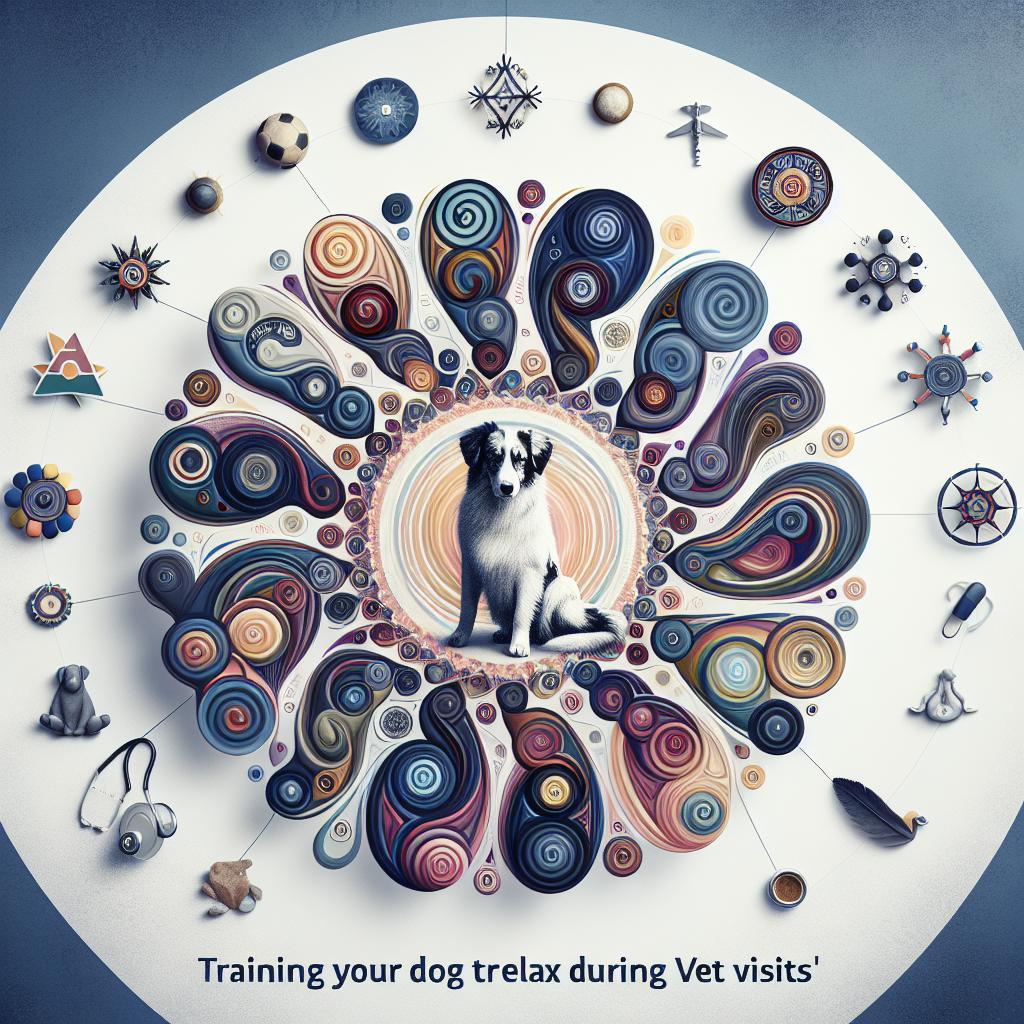Introduction:
Visiting the veterinarian can be a nerve-wracking experience for both dogs and their owners. The sterile environment, unfamiliar noises, and a host of new smells can transform even the most confident canine into a ball of anxiety. whether it’s a routine check-up or a necessary procedure, helping your furry friend maintain a sense of calm during these visits is crucial.In this article, we’ll explore effective techniques to train your dog to relax at the vet’s office, ensuring that each visit is as stress-free as possible. By employing patience and positive reinforcement, you can create a more pleasant experience that benefits not only your pet’s well-being but also the efficiency of their care. Join us as we delve into tips and strategies that will help your dog view the vet’s office as a less intimidating place and, ideally, even a little more inviting.
Understanding Your Dogs Anxiety Triggers at the Vet
Every dog is unique, and understanding the specific triggers of anxiety during vet visits can make all the difference. Common triggers include the sounds of other animals, unfamiliar smells, or even the sterile environment of the clinic itself. Identifying these factors can help you prepare your dog better for the experience. Consider creating a list of your dog’s particular triggers such as:
- Unfamiliar noises: Barking, meowing, or medical equipment sounds
- Strange people: New voices and faces can be intimidating
- Changes in routine: A trip to the vet often disrupts their normal schedule
Once you recognize these anxiety catalysts, you can work on desensitization and counter-conditioning techniques.For example, visit the vet’s office outside of appointments just for socialization practice. Bring along treats or favorite toys to create positive associations with the environment. Tracking your dog’s behavior during these visits can provide insights into how they adapt over time. A simple table can help monitor their progress:
| Visit Date | anxiety Level (1-10) | Positive Reinforcement Used | Notes |
|---|---|---|---|
| 01/01/2023 | 8 | Treats | Very nervous, hid under chair |
| 01/15/2023 | 5 | Treats, toys | Slightly calmer, explored waiting area |
| 02/01/2023 | 3 | Treats, praise | Approached staff, showed interest |
Building Positive Associations Through Gradual Exposure
To foster a positive experience for your dog during vet visits, gradual exposure is key.Start by introducing your furry friend to the veterinarian’s office without any medical procedures. Begin with short visits, allowing your dog to explore the waiting area, sniff around, and even get a few treats from the staff. This step helps your pup associate the clinic with fun experiences rather than fear. Consider taking your dog on trips to the clinic just for playtime—like a walk outside or a visit with friendly staff—to reinforce those good vibes.
As your dog becomes more comfortable in the environment,you can slowly expose them to the necessary procedures in a controlled manner. Such as, gently practice handling their paws, ears, and mouth at home, rewarding them with praise and treats. Additionally,consider creating a fun routine that includes frequent visits combined with positive interactions,such as:
- Meeting the vet for play sessions
- Rewarding with treats after a successful visit
- Engaging in calming activities like short walks after appointments
Using these methods,you’ll help your dog build a positive association with the vet,leading to a more relaxed atmosphere during actual visits.

effective Relaxation Techniques for a Calmer Visit
Creating a peaceful environment is crucial for your dog’s comfort during veterinary visits. Start with gentle handling techniques; pet them softly,speak in a calm tone,and let them sniff the surroundings and vet staff.Consider using a familiar blanket or toy they associate with comfort. This helps establish a safe space where your dog feels more secure. Incorporating positive reinforcement techniques, such as treats or praise, can also foster a positive atmosphere, encouraging your dog to remain calm. Utilizing these approaches creates a supportive experience that benefits both your pet and the clinic staff.
In addition to environmental adjustments, several relaxation techniques can be adopted to help your dog manage stress.Gradual exposure to the vet visit environment through short, regular trips can definitely help desensitize them. Implementing deep pressure therapy—like gentle hugging or pressure wraps—can soothe anxious dogs. You might also explore herbal remedies or calming sprays formulated for pets. To keep track of what works best, consider using the following table to record your dog’s reactions to different techniques:
| Technique | Effectiveness Rating (1-5) | Notes |
|---|---|---|
| Gentle Handling | 4 | Improved comfort; responds well to calmness. |
| Familiar Item | 5 | Substantially reduced anxiety. |
| Positive Reinforcement | 4 | Encouraged interaction with staff. |
| Deep Pressure Therapy | 3 | Moderate effectiveness; check for dog’s preferences. |

The Role of treats and Rewards in Reducing Stress
When it comes to helping our furry friends stay calm during vet visits, treats and rewards serve as powerful tools. By providing positive reinforcement, you can create a pleasant association with the veterinary experience. This works by encouraging your dog to focus on the goodies instead of the unfamiliar environment and possibly stressful examinations. Incorporate treats that are special and enticing, such as small soft bites or freeze-dried meats, to elevate their experience. Use these rewards during the visit to help create a more relaxed atmosphere and foster positive behaviors.
Additionally, consider timing your rewards effectively to maximize their impact. establish a routine where treats are given not just for good behavior, but also throughout the visit to reinforce calmness after each stressful moment.Here’s a quick table to guide you on how to distribute treats during the vet appointment:
| Moment | Action | Reward Type |
|---|---|---|
| Arrival | Calmly entering the clinic | Soft treat |
| Waiting | Sitting quietly | Praise + small biscuit |
| Examination | Staying still | Favorite toy + treat |
Implementing a rewarding system can transform your dog’s perception of vet visits from a fearful experience to a more relaxed one, paving the way for easier appointments in the future.
Q&A
Q&A: How to Train Your Dog to Relax During Vet Visits
Q: Why is it crucial for my dog to be calm during vet visits?
A: A calm dog makes the veterinary experience smoother for both the pet and the staff. Reducing stress can lead to more accurate examinations and treatments, ensuring your furry friend receives the best care possible. Additionally, a relaxed pet is less likely to experience fear-based reactions, which can be harmful and stressful in a medical setting.
Q: What are some signs that my dog is anxious during vet visits?
A: Dogs may show anxiety through various behaviors. Common signs include panting, whining, pacing, hiding, excessive drooling, or even aggression. Recognizing these signs can definitely help you address your dog’s stress early on.
Q: How can I prepare my dog for their vet visit?
A: Planning is key! Start by familiarizing your dog with the vet’s office environment.Take them for casual visits where they can explore the waiting area and meet the staff in a non-threatening manner. Bringing treats or toys can associate the space with positive experiences.
Q: Can training at home help my dog stay relaxed at the vet?
A: Absolutely! Basic training at home, such as teaching commands like “sit,” “stay,” and “down,” can provide your dog with a sense of structure and security. Incorporating relaxation techniques, like “settle” or “go to your mat,” can also reinforce calm behavior.
Q: What techniques can I use during the vet visit to help my dog relax?
A: Positive reinforcement is an excellent strategy. Bring along high-value treats to reward your dog for calm behavior. Practicing deep,controlled breathing can also help both you and your dog stay composed. Gentle petting or offering a favorite toy can provide comfort during examinations.
Q: How often should I train my dog for vet visits?
A: Consistency is essential! Incorporate short training sessions throughout the week leading up to the vet visit. Frequent practice helps reinforce desirable behaviors and builds comfort over time.
Q: What if my dog has a strong fear of the vet?
A: if your dog has a severe fear of the vet, consider consulting a professional dog trainer or a veterinary behaviorist. They can provide tailored strategies, including desensitization techniques, to help your dog gradually overcome their anxiety.Q: What should I do if my dog becomes aggressive during a vet visit?
A: Safety is paramount. If your dog displays aggression,calmly communicate with the veterinary staff about your dog’s behavior. They may suggest scheduling appointments during quieter times or having a muzzle available for safety. Ongoing behavior modification training will also be key to addressing this issue.
Q: Are there any products that can help my dog relax at the vet?
A: yes, consider products like calming sprays, anxiety wraps, or pheromone diffusers designed to help dogs feel more at ease. Always consult with your veterinarian before introducing any new products to ensure they’re suitable for your pet.
Q: How can I maintain my dog’s relaxation routine after the vet visit?
A: Continue to reinforce positive behaviors after each visit by celebrating your dog’s accomplishments, no matter how small. Regular outings to the vet for non-medical purposes can also help maintain their comfort in the environment over time. Remember, practice makes perfect!
In Summary
helping your dog learn to relax during vet visits is a journey that requires patience, consistency, and a sprinkle of creativity.By implementing the techniques discussed, you not only ease your pet’s anxiety but also strengthen the bond between you and your furry friend. Remember, every dog is unique, and finding the right approach may take some time, so don’t be discouraged by setbacks. Celebrate each small victory along the way. With your continued dedication and a positive attitude, those daunting trips to the vet can transform into manageable and even pleasant experiences. Here’s to healthier, happier visits that set the stage for a calm and confident canine!

